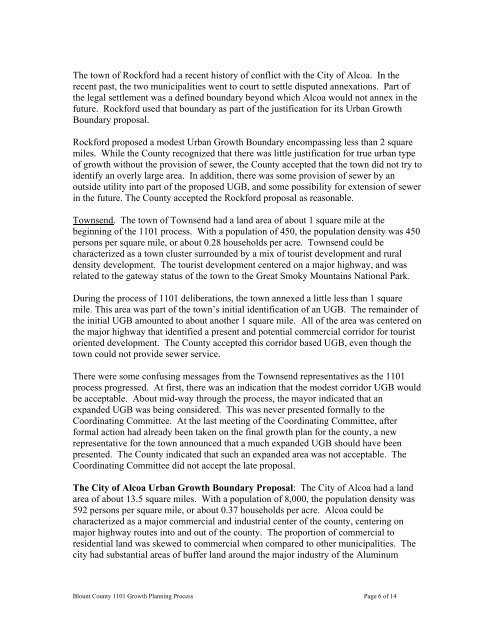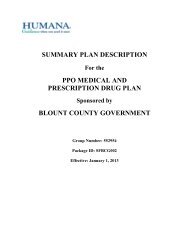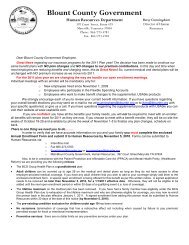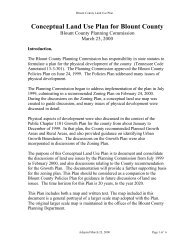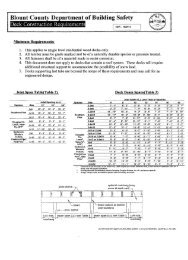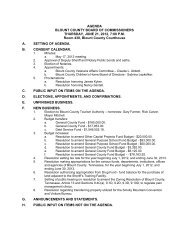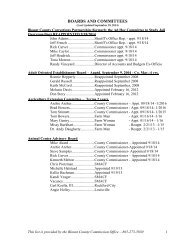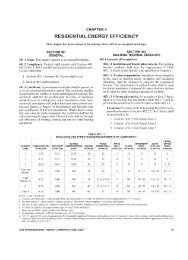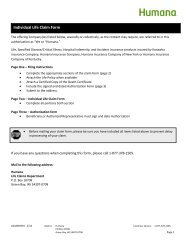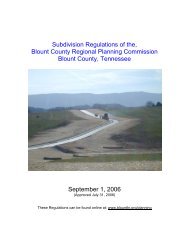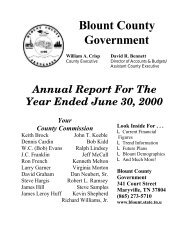Reflections on the 1101 Process in Blount County, Tennessee
Reflections on the 1101 Process in Blount County, Tennessee
Reflections on the 1101 Process in Blount County, Tennessee
You also want an ePaper? Increase the reach of your titles
YUMPU automatically turns print PDFs into web optimized ePapers that Google loves.
The town of Rockford had a recent history of c<strong>on</strong>flict with <strong>the</strong> City of Alcoa. In <strong>the</strong>recent past, <strong>the</strong> two municipalities went to court to settle disputed annexati<strong>on</strong>s. Part of<strong>the</strong> legal settlement was a def<strong>in</strong>ed boundary bey<strong>on</strong>d which Alcoa would not annex <strong>in</strong> <strong>the</strong>future. Rockford used that boundary as part of <strong>the</strong> justificati<strong>on</strong> for its Urban GrowthBoundary proposal.Rockford proposed a modest Urban Growth Boundary encompass<strong>in</strong>g less than 2 squaremiles. While <strong>the</strong> <strong>County</strong> recognized that <strong>the</strong>re was little justificati<strong>on</strong> for true urban typeof growth without <strong>the</strong> provisi<strong>on</strong> of sewer, <strong>the</strong> <strong>County</strong> accepted that <strong>the</strong> town did not try toidentify an overly large area. In additi<strong>on</strong>, <strong>the</strong>re was some provisi<strong>on</strong> of sewer by anoutside utility <strong>in</strong>to part of <strong>the</strong> proposed UGB, and some possibility for extensi<strong>on</strong> of sewer<strong>in</strong> <strong>the</strong> future. The <strong>County</strong> accepted <strong>the</strong> Rockford proposal as reas<strong>on</strong>able.Townsend. The town of Townsend had a land area of about 1 square mile at <strong>the</strong>beg<strong>in</strong>n<strong>in</strong>g of <strong>the</strong> <strong>1101</strong> process. With a populati<strong>on</strong> of 450, <strong>the</strong> populati<strong>on</strong> density was 450pers<strong>on</strong>s per square mile, or about 0.28 households per acre. Townsend could becharacterized as a town cluster surrounded by a mix of tourist development and ruraldensity development. The tourist development centered <strong>on</strong> a major highway, and wasrelated to <strong>the</strong> gateway status of <strong>the</strong> town to <strong>the</strong> Great Smoky Mounta<strong>in</strong>s Nati<strong>on</strong>al Park.Dur<strong>in</strong>g <strong>the</strong> process of <strong>1101</strong> deliberati<strong>on</strong>s, <strong>the</strong> town annexed a little less than 1 squaremile. This area was part of <strong>the</strong> town’s <strong>in</strong>itial identificati<strong>on</strong> of an UGB. The rema<strong>in</strong>der of<strong>the</strong> <strong>in</strong>itial UGB amounted to about ano<strong>the</strong>r 1 square mile. All of <strong>the</strong> area was centered <strong>on</strong><strong>the</strong> major highway that identified a present and potential commercial corridor for touristoriented development. The <strong>County</strong> accepted this corridor based UGB, even though <strong>the</strong>town could not provide sewer service.There were some c<strong>on</strong>fus<strong>in</strong>g messages from <strong>the</strong> Townsend representatives as <strong>the</strong> <strong>1101</strong>process progressed. At first, <strong>the</strong>re was an <strong>in</strong>dicati<strong>on</strong> that <strong>the</strong> modest corridor UGB wouldbe acceptable. About mid-way through <strong>the</strong> process, <strong>the</strong> mayor <strong>in</strong>dicated that anexpanded UGB was be<strong>in</strong>g c<strong>on</strong>sidered. This was never presented formally to <strong>the</strong>Coord<strong>in</strong>at<strong>in</strong>g Committee. At <strong>the</strong> last meet<strong>in</strong>g of <strong>the</strong> Coord<strong>in</strong>at<strong>in</strong>g Committee, afterformal acti<strong>on</strong> had already been taken <strong>on</strong> <strong>the</strong> f<strong>in</strong>al growth plan for <strong>the</strong> county, a newrepresentative for <strong>the</strong> town announced that a much expanded UGB should have beenpresented. The <strong>County</strong> <strong>in</strong>dicated that such an expanded area was not acceptable. TheCoord<strong>in</strong>at<strong>in</strong>g Committee did not accept <strong>the</strong> late proposal.The City of Alcoa Urban Growth Boundary Proposal: The City of Alcoa had a landarea of about 13.5 square miles. With a populati<strong>on</strong> of 8,000, <strong>the</strong> populati<strong>on</strong> density was592 pers<strong>on</strong>s per square mile, or about 0.37 households per acre. Alcoa could becharacterized as a major commercial and <strong>in</strong>dustrial center of <strong>the</strong> county, center<strong>in</strong>g <strong>on</strong>major highway routes <strong>in</strong>to and out of <strong>the</strong> county. The proporti<strong>on</strong> of commercial toresidential land was skewed to commercial when compared to o<strong>the</strong>r municipalities. Thecity had substantial areas of buffer land around <strong>the</strong> major <strong>in</strong>dustry of <strong>the</strong> Alum<strong>in</strong>um<strong>Blount</strong> <strong>County</strong> <strong>1101</strong> Growth Plann<strong>in</strong>g <strong>Process</strong> Page 6 of 14


